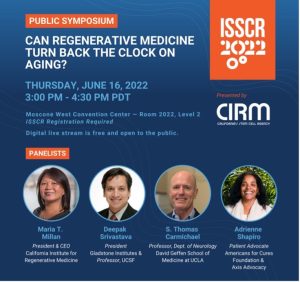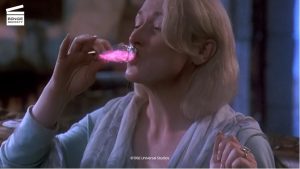 When I heard that the International Society for Stem Cell Research (ISSCR) was hosting a public symposium to ask if regenerative medicine can turn back the clock on aging, my interest was piqued.
When I heard that the International Society for Stem Cell Research (ISSCR) was hosting a public symposium to ask if regenerative medicine can turn back the clock on aging, my interest was piqued.
The enthusiasm for putting the brakes on aging has been documented as early as the second millennium BC, when mention of an elixir of life is found in the Epic of Gilgamesh, the poem from ancient Mesopotamia regarded as the earliest surviving notable literature. According to the summary on Wikipedia, Gilgamesh comes to fear his own declining years following the death of his beloved companion Enkidu.
Kicking off the Symposium, Dr. Jonathan Thomas, Chair of the California Institute for Regenerative Medicine (CIRM), asked the audience for a show of hands to gauge the topic’s relevance. “Who here is getting older?” he asked, noting he would like to catch up with anyone who didn’t raise their hands, after the conference, for their secrets.
The idea of an elixir of youth reminded me of Death Becomes Her, the 1992 black comedy in which Meryl Streep and Goldie Hawn discover the secret of eternal youth in a magic potion, though it comes with significant side effects, putting the services of an embalmer (Bruce Willis) in high demand! (A recent Signals blog states that Willis is now living with, and raising awareness of, Asphasia, a language disorder frequently caused by strokes, which regenerative medicine will ideally cure one day.)
It’s a wild movie plot but, as it turns out, some lines of investigation in regenerative medicine, targeting the aging process, are equally “out there.” Introducing the Q&A session, Dr. Thomas invited the panel to comment on a couple of topics that are not just cutting edge, but exemplify some of the “pretty wild stuff” going on in the field, as Dr. Thomas put it.
The first topic was recent activity in parabiosis research (parabiosis is the surgical union of two organisms to allow sharing of a single physiological system, for example muscular, blood circulatory, skeletal, skin, etc.). See Molecular hallmarks of heterochronic parabiosis at single-cell resolution published in Nature this March.
“Parabiosis is pretty wild and the notion in this, for those of you who may not be familiar with it, is that there may be some factor or factors in a young person or animal’s blood that, when transferred into an older individual, rejuvenates and makes the older individual’s cells younger again,” remarked Dr. Deepak Srivastava, President, Gladstone Institutes, who the question was first directed to. He was keen to acknowledge it may sound far-fetched. “It sounds science-fiction-y or just wacky, but in fact you can see if you sew two mice together [one older and one younger], which has been done, a number of features of older organs that we can measure look more similar to a younger organ. So, I think there’s tremendous promise in that line of investigation.”
Dr. Srivastava was keen to note that this promise does not lie in sewing people together, rather, in figuring out the secrets of what might be circulating in the blood of a young mouse or individual, purifying this, and turning it into a therapeutic.
“What it does say, which I think is the most important part of that line of investigation to me, is that this notion of a cell just getting old is reversible… When we observe that, one has to step back and say that the idea that an old cell can’t go back in time is just wrong, and it’s just up to us to figure out how to do it.” Cheers to that!
Watch the full public symposium below for more on this and a range of other topics, from genetically modified pigs’ hearts that are programmed to stop growing (so they don’t get too big when transplanted into humans), to heart disease, stroke, and the vital role that patients and patient advocates play in helping to advance work in regenerative medicine.
Cal Strode
Latest posts by Cal Strode (see all)
- World AIDS Day: Update on HIV cure research and gene therapies - December 1, 2025
- Headwinds and tailwinds for cell and gene therapy under the second Trump administration - March 11, 2025
- From innovation to international impact: ARM’s 2025 “State of the Industry Briefing” showcases maturing CGT industry - January 20, 2025







Aging is an unavoidable but extendable process. Advancells provides a shield of stem cells combined with growth factor is a primary target for absorbing the shock of aging.
It is one of the top leaders for stem cell and anti-aging. Happy Client
Excellent article. While Parabiosis does seem far fetched and whacky it warrants attention as to what factors help the older mice to rejuvenate. Recently I heard on a podcast of feacal transplant from young healthy mice which helped older mice to recover from disorders indicating that even microbiota from young individuals differ and can be used to treat aging. Infact very soon regenerating gut microbiota is going to be a new norm to reverse some side effects of aging.
Thank you very much Krupa. Microbiota wasn’t mentioned in this ISSCR session, but this does sound very interesting – please let me know the name of the podcast/episode if you would recommend it, I’d be interested in listening!